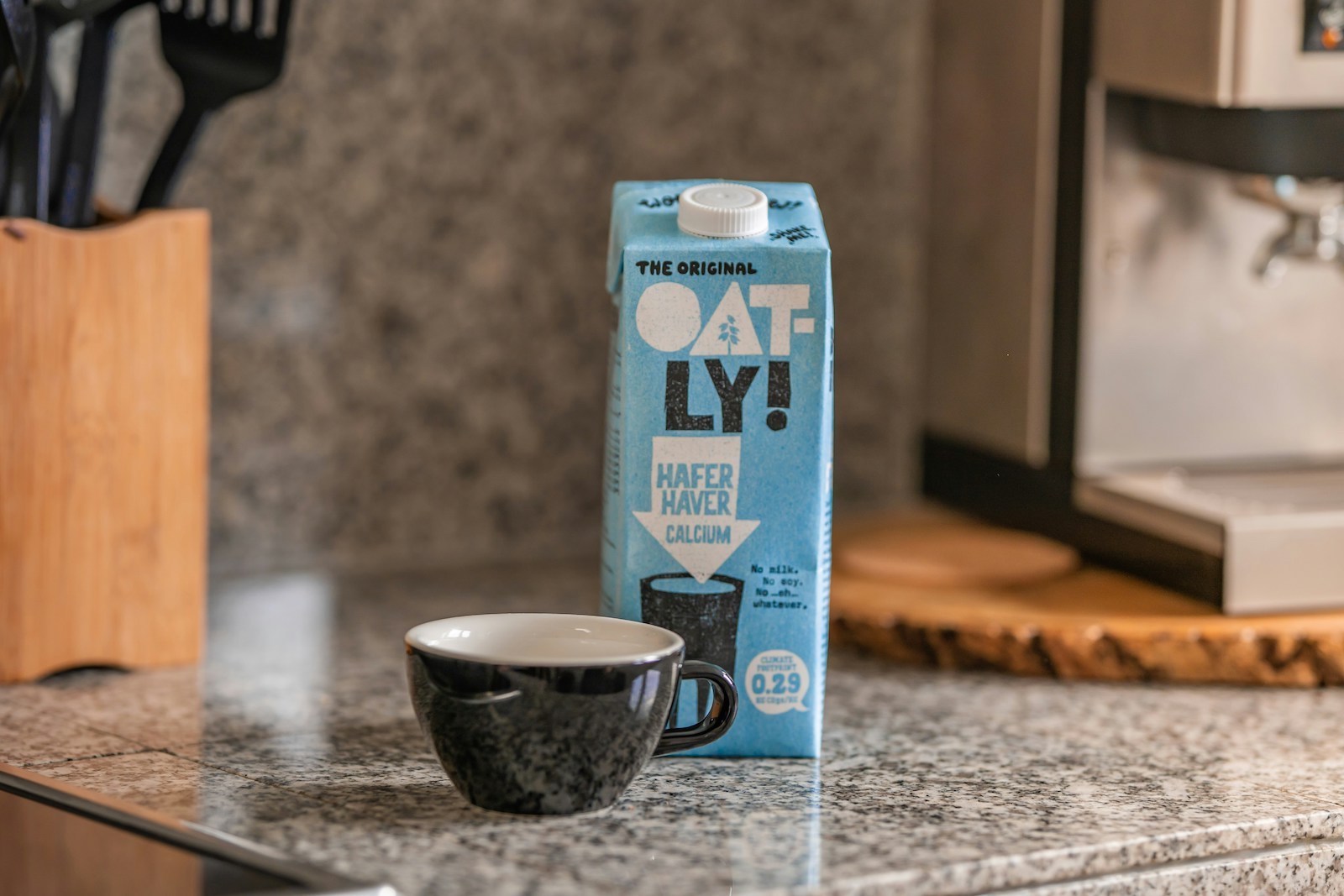As an Amazon Associate I earn from qualifying purchases.

In the epoch of rising consciousness about nutrition and dietary choices, many consumers are turning away from conventional cow’s milk and looking towards plant-based alternatives. Among the broad spectrum of options like almond milk, soy milk, and coconut milk, one variant has successfully stood out from the crowd – Oat milk. But what is oat milk, and why is it gaining so much popularity? Let’s dive in and find out more.
History of Oat Milk
Simply put, oat milk is a delicious, nutritious beverage made from soaked, blended, and strained oats. It has become a sensation for its creamy texture which rivals dairy milk, making it a popular choice among vegans and those with lactose intolerance.
The Dawn of Oat-Based Beverages
The illustrious history of oat milk started in the late 1980s. While oat milk is popular today, its origins trace back to an era when plant-based milks were not as prevalent as they are now. It began in the Nordic countries, specifically Sweden, where oats boast abundant growth thanks to the suitable soil and climate conditions.
Swedish scientist Rickard Öste is widely credited with pioneering commercial oat milk. His fascination with oats as a sustainable food source led him to experiment and eventually develop a process to create a milk-like beverage from oats.
The Birth of Oatly: The First Commercial Oat Milk
In 1994, Öste co-founded Oatly, the first company to commercialize oat milk on a global scale. Through specially designed enzymes, the company breaks down the oat starch into maltose, a type of sugar that gives oat milk its distinct sweet flavour. Oatly’s innovation did not stop there, as they developed an array of oat milk varieties, including barista edition, unsweetened, and chocolate-flavoured versions, which continue to delight taste buds internationally.
Oat Milk in the 21st Century
The early 2000s ushered in a new era for oat milk. Conscious consumers began seeking plant-based alternatives for health, ethical and environmental reasons. This shift in preferences allowed oat milk to claim a prominent spot in the ever-growing plant-based milk market.
The real turning point, however, came in 2016 when Oatly introduced its barista edition oat milk. The unique formulation, which froths just like dairy milk, won over coffee lovers and baristas alike, heralding a paradigm shift in the café culture.
Growing Popularity around the Globe
Today, oat milk has emerged as a raging success story in the dairy-free milk industry. With ever-increasing concerns about lactose intolerance, allergies, and ethical considerations driving demand, oat milk’s popularity shows no sign of slowing down. What began as a Nordic experiment a few decades ago has evolved into a global phenomenon.
In North America, a surge in demand led to an infamous oat milk shortage in 2018. Markets in Europe, Australia, and Asia, too, are showing increased interest in this plant-based beverage.
Countless Health Benefits
Oat milk isn’t just a tasty alternative to traditional dairy milk; it’s packed with several health benefits that make it a must-try. It is rich in B vitamins, provides a great source of plant-based protein, and is free from allergens present in some plant-based milks, such as nuts and soy. It is also a good option for individuals with dietary restrictions, as it is naturally free of lactose, dairy, and cholesterol.
An Eye to the Future
With science and innovation continually driving the plant-based food industry forward, the future looks promising for oat milk. As more brands get on the oat milk bandwagon, there’s potential for even greater variety and improved formulations.
In conclusion, oat milk’s relatively recent history is an inspiring journey of sustainability, scientific innovation, and response to consumer needs. Now a supermarket staple, oat milk is loved for its taste, versatility, health benefits, and environmental friendly nature, and its thrilling journey is far from over.
How Oat Milk is Made

As the popularity of plant-based diets continues to surge, oat milk emerges as the hero for many. But what is oat milk, and how is it produced? Oat milk adds lush creaminess to your coffees and is loved for its nutty taste and environment-friendly production process. Let’s delve deeper into this fascinating manufacturing process.
The Origin of Oats
The story starts at ground zero, with humble oats. Primarily grown in North America and Europe, oats thrive in colder temperatures and moist soil. Dedicated to prime quality, manufacturers handpick the best quality oats that boast of high nutritional values.
Soaking and Milling
The process ushers in once the oats are harvested. After rigorous cleaning to free the grains of potential impurities, the oats are soaked for a certain period in water. This soaking helps to soften the hard grain and makes it more malleable for processing. Thereafter, the oats and water are blended together to form a slurry. Milling or grinding oats into small pieces helps to extract as much nutritional value and creaminess as possible.
Enzyme Activation
The next crucial step in the production process of oat milk is enzyme activation or enzymatic liquefaction. The oat slurry is heated, causing the enzymes present in the oats to break down the starches into smaller maltose or glucose units. This transformation enhances the sweetness and creaminess of the oat milk naturally.
Separation
After enzymatic liquefaction, a process called centrifugation takes place. The oat slurry is spun very rapidly in a centrifuge. It separates the remaining solid parts from the liquid. These solids, often referred to as the oat pulp, can be used in various forms or as an agricultural fertilizer.
Pasteurization
The oat milk is then heat-treated or pasteurized to ensure it’s safe for consumption. This process eliminates any remaining bacteria or other microorganisms that could hamper the milk’s quality.
Fortification
In the final stage of production, the oat milk is fortified. Nutritional components like calcium, Vitamin D, Vitamin A are individually added to make the oat milk healthier and more beneficial. Additional flavors like vanilla or chocolate may be introduced in this stage based on the variant being produced.
Packaging
The fortified oat milk is swiftly moved to a packaging station to minimize exposure to the open environment. It is often packed in aseptic packaging to ensure longer shelf life without the use of preservatives.
And that is the detailed journey of oat milk from a grain to a delicious, creamy, and healthy dairy alternative. It is a testament to how nature and technology can work beautifully together to produce a nourishing product like oat milk. Every step in this production process vouches for the quality, safety, and creamy texture oat milk is loved for. So, the next time you stir oat milk into your coffee or whip up a smoothie, you will appreciate it even more.
Understanding the production process of products we consume is integral to being a conscious consumer, and appreciating the stages and efforts involved in the journey from farm to table.
Health Benefits of Oat Milk
As more people journey into plant-based diets, many question, “What is oat milk, and is it beneficial to our health?” Oat milk, derived from whole oat grains, is a delightful vegan alternative to traditional dairy-based milk. However, does it possess any health benefits worth making a switch?
Rich in Nutrients
Oat milk is a rich nutrient source, ensuring people get a nutrient-filled addition to their meals. It is commonly fortified with vitamins A, D, B2, and B12, as well as various minerals such as calcium and iron – nutrients that are usually found in dairy milk. Additionally, unsweetened varieties contain zero added sugars, making oat milk an excellent choice for individuals looking to reduce their sugar intake for health reasons.
Promotes Heart Health
One significant benefit of oat milk is its potential to boost heart health. Oats are rich in beta-glucans, a type of soluble dietary fiber known to reduce bad cholesterol levels. A diet rich in high-fiber foods like oat milk may lower the risk of developing heart disease, making oat milk an excellent choice for heart-conscious consumers.
Aids Digestive Health
The abundant soluble fiber in oat milk can also contribute positively to your digestive health. Soluble fiber adds bulk to your stools, promoting regular bowel movement and preventing constipation. Moreover, it feeds beneficial gut bacteria, enhancing your overall gut health and boosting your immunity.
Excellent for Bone Health
One key advantage of oat milk is its calcium and vitamin D content. Regular consumption can actively strengthen bones, teeth and aid in the prevention of osteoporosis.
Lactose and Allergy Friendly
For individuals who are lactose intolerant or allergic to soy and nuts, oat milk is the ideal alternative. It is naturally lactose-free, nut-free, and typically low in allergens, allowing many people who cannot consume regular milk to enjoy its creamy texture without any unpleasant side effects.
Perfect for Vegans
The vegan diet eliminates animal products, presenting quite a challenge when sourcing certain nutrients. Oat milk is fully plant-based, making it an ideal vegan-friendly alternative to dairy milk. Additionally, it is often fortified with essential nutrients – B vitamins and Omega-3s, making it a substantial dietary supplement for vegans.
Despite being a relatively new player in the dairy-free milk market, oat milk has quickly taken a solid stand, earning a devoted fan base thanks to its creamy texture, subtle sweetness, and of course, its extensive list of health benefits. From promoting heart and bone health to enhancing digestive wellbeing, oat milk is more than a delicious dairy substitute; it’s a nutrient-packed beverage well worth incorporating into your regular diet.
Whether you’re lactose intolerant, vegan or simply enjoy trying new health foods, oat milk can be a beneficial addition to your dietary routine. For the best health results, aim for varieties that are unsweetened and fortified with vitamins and minerals. As always, it’s important to consume it as part of a balanced and nutritious diet.
Why is Oat Milk Becoming Popular?

In recent years, oat milk has skyrocketed in popularity, becoming the preferred choice for many seeking a dairy-free and sustainable alternative. But what is oat milk, and why is it gaining such widespread acclaim?
Exploring the Appeal: What Sets Oat Milk Apart?
Creamy Consistency: What sets oat milk apart is its creamy texture, akin to traditional dairy milk. This characteristic makes it an ideal substitute in various recipes, from coffee to baking, offering a smooth and rich mouthfeel that satisfies the taste buds.
Neutral Flavor Profile: Unlike some plant-based alternatives, oat milk boasts a neutral flavor profile. This neutrality allows it to seamlessly integrate into both sweet and savory dishes without overpowering the existing taste, making it a versatile addition to the culinary repertoire.
The Oat Milk Production Process: Simplicity in Creation
Minimalist Ingredients: Oat milk is crafted through a straightforward process. Whole oat grains are soaked, blended, and strained to produce a liquid with a consistency similar to dairy milk. This minimalistic approach resonates with those seeking clean and natural alternatives to heavily processed options.
Environmental Friendliness: The production of oat milk is not only simple but also environmentally friendly. Oats require less water to cultivate compared to nuts used in other plant-based alternatives. This sustainability factor has contributed to oat milk’s appeal among eco-conscious consumers.
The Health Angle: Nutritional Benefits and Considerations
Nutrient-Rich Profile: Oat milk is not just about taste and texture; it also offers a nutrient-rich profile. Fortified versions are often a good source of vitamins D and B12, while the inherent beta-glucans in oats contribute to heart health and lower cholesterol levels.
Considerations for Consumption: While oat milk provides numerous health benefits, it’s crucial to be mindful of commercial variations that may contain added sugars or flavorings. Opting for unsweetened versions and checking labels helps ensure you’re making a health-conscious choice.
Barista’s Delight: Oat Milk in Coffee Culture
Frothy Perfection: Oat milk has become a favorite among baristas and coffee enthusiasts. Its ability to create a creamy and stable foam makes it an excellent addition to coffee, resulting in the perfect frothy texture that enhances the coffee-drinking experience.
Versatility in Beverages: Beyond coffee, oat milk’s versatility extends to a myriad of beverages. It can be seamlessly incorporated into smoothies, lattes, teas, and more, offering a delightful twist to traditional recipes.
A Dietary Ally: Catering to Diverse Preferences
Allergy-Friendly Option: Oat milk stands out as an allergy-friendly alternative. With its nut-free and soy-free composition, it caters to individuals with common allergies, providing a safe and delicious option for those seeking alternatives to dairy or other plant-based beverages.
Vegan and Plant-Based Appeal: As vegan and plant-based diets gain momentum, oat milk aligns seamlessly with these lifestyle choices. Its plant-derived nature makes it a suitable option for those embracing a cruelty-free and environmentally conscious approach to nutrition.
Brands and Innovations: Contributing to the Oat Milk Craze
Brand Diversity: The popularity of oat milk has led to a surge in the availability of various brands, each offering its unique spin on this dairy alternative. From established players to newer entrants, the diversity of options caters to different taste preferences and nutritional needs.
Flavored Varieties and Blends: To meet evolving consumer demands, many brands now offer flavored varieties and specialty blends. Vanilla, chocolate, and even barista-specific oat milks are available, adding a flavorful dimension to the oat milk landscape.
Looking Ahead: Oat Milk’s Promising Future
Continued Growth: As oat milk continues to dominate the non-dairy market, its future looks promising. With ongoing innovations, collaborations, and increased consumer awareness, oat milk is poised to remain a staple in households and coffee shops alike.
DIY Enthusiasm: Additionally, the popularity of oat milk has spurred a DIY culture, with individuals experimenting with homemade oat milk recipes. This hands-on approach allows for customization, giving enthusiasts control over ingredients and flavor profiles.
In conclusion, the meteoric rise of oat milk can be attributed to its creamy texture, neutral taste, and versatility in various applications. Its simplicity in production, coupled with environmental sustainability, appeals to those seeking clean and eco-friendly alternatives. As the oat milk phenomenon continues, consumers can anticipate further innovations, expanding the realm of possibilities for this beloved dairy alternative.
Whether sipped in a latte, poured over cereal, or incorporated into a favorite recipe, oat milk has undeniably secured its place in the dietary spotlight, offering a wholesome and delectable choice for a diverse range of preferences.
Environmental Impact of Oat Milk

Environmental Pros of Oat Milk
Oat milk boasts several eco-friendly aspects that make it a favored choice. Primarily, it requires significantly less water to produce than almond, cow, and soy milk. Producing a single liter of oat milk only requires 48 liters of water, compared to almond milk, which needs a staggering 371 liters. Moreover, oats are a hardy crop that can thrive in unsuitable conditions, reducing the need for utilizing fertile land.
Oat milk production also generates less greenhouse gas emissions than other types of milk. In fact, it only produces a third of the emissions that the dairy industry creates. This aspect is pivotal in reducing the overall carbon footprint, hence contributing to combatting climate change.
Furthermore, oat cultivation significantly contributes to soil health. They are known for their nitrogen scavenging abilities, which means they can absorb surplus nitrogen from soil that could otherwise convert into a greenhouse gas. Thus, their growth helps to maintain a healthy, nutrient-rich soil ecosystem.
Environmental Challenges of Oat Milk
In spite of the considerable environmental benefits oat milk provides, it isn’t completely devoid of challenges. Processing oats into milk involves significant energy consumption. This energy is often sourced from non-renewable resources, which can contribute to the emission of greenhouse gases.
Packaging also plays a major role in the environmental impact of oat milk. Most oat milk brands use Tetra Pak cartons, which are highly recyclable. However, the rate of recycling these cartons is quite low worldwide. Notably, in the US, the recycling rate is just 16%, meaning many end up in landfill, poorly affecting the environment.
Looking Forward
Companies have already started investing in solutions to overcome these challenges. For instance, Oatly, a prominent oat milk maker, uses clean energy for the majority of its production. They are also working on implementing a full life-cycle approach to packaging using bio-based materials that would replace the current, less environmentally friendly options.
As consumers, we can play a part by choosing brands committed to environmentally friendly practices. Additionally, recycling packaging properly would significantly reduce the potential environmental impact of oat milk.
Overall, oat milk presents a more sustainable and eco-friendly alternative to dairy and even some other plant-based milks. While it has issues to address, its producers are mindful and working towards more sustainable solutions. As consumers become more environmentally conscious, the potential for oat milk to become a standard of sustainable food consumption continues to grow.
Is Oat Milk Here to Stay?
As consumers continue to prioritize healthier and sustainable food choices, the popularity of this delicious milk seems set to skyrocket. It has established its place in the industry, carving out a significant space in the dairy alternative market.
While most food and beverage trends ebb and flow, the multiple benefits and flexible uses of oat milk suggest that this is not just a fleeting trend. The question isn’t anymore “what is oat milk?”; instead, it’s “why wouldn’t you choose oat milk?”
The nutty, creamy essence of oat milk, coupled with its impressive health benefits and reduced environmental impact, has secured its booming popularity. As more and more people embrace plant-based diets and sustainable lifestyle choices, oat milk’s popularity is anticipated to continue rising.
Its debut is a testament to the constant evolution of the food industry catering to consumers’ demands—at the intersection of health, sustainability, and taste. Whether you’re a latte lover, a vegan foodie, or simply someone seeking an eco-friendly alternative, oat milk is here to stay.
Ways to Enjoy Oat Milk

Renowned for its creamy, pleasant taste, and loaded with nutrients, it’s not surprising that oat milk consumption is rapidly on the rise. Not only is it a sanctified savior for lactose intolerant folks, but also a delightful part of any lifestyle. Allow us to spill the oats on the numerous ways to enjoy oat milk.
Get a Brew-tiful Start to Your Morning
Oat milk and coffee are a match made in heaven. With the right handheld milk frother for oat milk, the smooth, velvety texture of oat milk perfectly complements the robust flavors of coffee, creating a divine morning beverage. Whether you prefer a frothy latte, a strong cappuccino, or a humble cup of black coffee, oat milk can lend its charm to all. Its natural sweetness can also lessen the need for additional sugar, making your morning brew healthier.
Creamy Smoothies and Shakes
Smoothies and shakes are inherently healthy and energizing. Still, when combined with oat milk, their nutritional quotient skyrockets. Mix fruits, berries, nuts, seeds, or anything you fancy, and add a generous pour of oat milk. The resulting smoothie will be incredibly luscious – a delicious way to recharge your batteries!
Bring Magic to your Baking
The consistency of oat milk makes it an ideal ingredient in baking. It blends seamlessly with other ingredients to create soft, moist cakes and cookies. Moreover, oat milk’s subtle flavor enhances the overall taste without overpowering it. Whether you’re whipping up pancakes for breakfast or baking a cake for a special occasion, you can trust oat milk to bring a wonderful twist to your recipes.
Healthy Breakfast Cereals
Who says breakfast cereals can’t enjoy a duet with oat milk? Just pour chilled oat milk over your favorite cereal and jumpstart your day on a healthy note. Oat milk gives a creamy richness to your cereal while keeping it more wholesome than traditional dairy milk.
Savory Cooking Delights
Think oat milk is only for sweet treats? Think again. It is a versatile player that can enhance your savory dishes too. Try adding it to your soups to make them creamier, or use it in your pasta sauces for an exceptionally smooth finish. Its mild flavor profile allows oat milk to blend effortlessly into any cuisine, transforming humble food into gourmet meals.
Indulge in Tasty Desserts
Elevate your ice cream experience by using oat milk. Its creamy, indulgent texture makes decadent scoops that are guilt-free and delicious. It can also be used to prepare a range of desserts – from panna cottas and puddings to custards and cheesecakes, the options are endless.
Clearly, there are countless ways to incorporate oat milk in your daily diet, and each one promises to be as heartwarming and flavorsome as the other. Whether you are reluctant to use dairy products or simply want to experiment with your food, oat milk is an ideal ingredient to use. So, reshuffle your grocery list and make room for this incredibly versatile and mouthwatering dairy alternative. Your tastebuds will surely thank you!
Home-Made Oat Milk

Gaining popularity recently, oat milk offers a host of health benefits which we’ll delve into in a moment. But, fear not, you needn’t scour the supermarket aisles to procure this fabulous beverage when you can create your own homemade oat milk in your kitchen! Let’s roll into it.
Oat Milk: The Powerhouse of Nutrients
But first, why oat milk? Oat milk is a nutrient-rich, creamy alternative to traditional milk perfect for those who are lactose intolerant or vegans. It’s packed with vitamins, fiber, and is a wonderful source of beta-glucan, a type of soluble fiber which can help in lowering cholesterol levels. Additionally, it maintains a delicate sweetness and smooth texture that decidedly adds value to your favorite meals and beverages.
Making Your Home-made Oat Milk: Step by Step
Making oat milk at home is incredibly easy. To start, you will need just two primary ingredients: oats and water. For those who are interested in a bit of sweet taste, adding a pitted date or a splash of vanilla extract won’t be a wrong move.
Step 1: Soaking the oats
The first step, soaking the oats, is crucial and about as difficult as it sounds. For one cup of oats, cover them with water and let them soak for at least 15 minutes, but overnight is preferable.
Step 2: Rinsing and draining
It’s now time to drain and rinse the oats. If you skip this step, you may end up with a slimy concoction, and no one wants that.
Step 3: Blend and strain
Next, combine the oats and fresh water (roughly a 1:3 ratio) in a blender until smooth. Then, strain the mixture through a fine-mesh strainer or use a nut milk bag. And there you have it, your delicious homemade oat milk is ready.
Eye-Opening Facts about Homemade Oat Milk
One enticing aspect of homemade oat milk is knowing exactly what’s in it. Unlike store-bought varieties, you can adjust the consistency and sweetness to suit your palate without worrying about added sugars or preservatives.
Besides the nutritional aspect, homemade oat milk also presents ecological benefits. By making your oat milk, you reduce the amount of plastic or Tetra Pak waste associated with store-bought options.
Finally, homemade oat milk is a boon for your wallet. The affordability of oats as compared to almonds or soy make it a pocket-friendly choice for those looking to explore plant-based milk alternatives.
Versatility of Oat Milk
Beyond just a glass of cool, refreshing milk, your homemade oat milk can work wonders in your kitchen. Think pancakes drizzled with oat milk syrup, or a scrumptious smoothie with a creamy oat milk base, or even frothy oat milk to crown your morning coffee. Oat milk exhibits the chameleon-like ability to assimilate beautifully into a multitude of culinary applications.
Conclusion
There you have it– a simple, nutritional, and eco-friendly alternative to traditional milk, and how to make it from scratch–homemade oat milk. Full of heart-friendly beta glucans and devoid of lactose, it’s a great addition to your dietary roster. So why not give your next bowl of cereal or cup of coffee a homemade oat milk twist and witness the creamy delight it has to offer? Bust out that blender and start enjoying the many benefits of homemade oat milk!
Wrapping Up
Intriguing isn’t it, to learn what oat milk is? A by-product of humble oats that’s profoundly nutritious and equally appetizing. It caters to all – whether environmental enthusiasts, the lactose-intolerant, individuals with nut allergies, or those simply looking for an enjoyable dairy-free alternative!
The shift towards oat milk is a testament to the changing health patterns and emphasis on sustainable living. Go ahead, try a glass of oat milk. You never know, you might just find your new favorite beverage!
Amazon and the Amazon logo are trademarks of Amazon.com, Inc, or its affiliates.